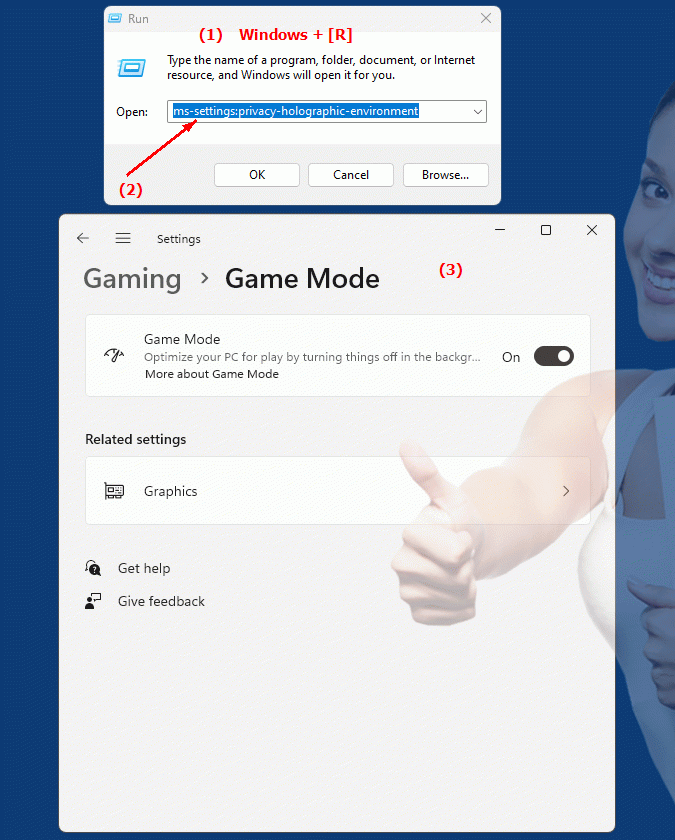The URL and protocol URL "ms-settings:privacy-holographic-environment" opens the privacy and permissions settings for the Holographic Environment in Windows 10 und 11 .
These settings allow users to configure the permissions for using holograms and augmented reality (AR) content, including managing access rights for the system's holography features. Here is a detailed description of the availability of this feature in different Windows versions and the corresponding build numbers:
1. ms-settings:privacy-holographic-environment
2. Availability under Windows
3. Other useful commands in the Windows settings
1. The Command ms-settings:privacy-holographic-environment
1. Combine the Windows R keys for quick access.2. Use the command: ms-settings:privacy-holographic-environment to perform the desired step.
(The command is also useful for creating a desktop shortcut.)
3. Select OK or press [Enter] to confirm.
(... see Image-1 Point 1 to 3)
The settings explained above are now available to you in Windows 10, 11 or 12.
In this way, the following questions and challenges can be overcome.

1b. In this way, the following questions and challenges can be overcome.
How can I set permissions for using holograms and augmented reality in Windows?What settings are available to manage access rights for the holography functions in the system?
How do I adjust privacy and permission settings for the holographic experience in Windows?
Is there a way to configure specific access rights for holograms and AR content in the system?
Can I access the holographic environment features through the privacy and permission settings?
What options does Windows offer for managing access rights for holography functions in the system?
How can I configure permissions for holographic environments in different versions of Windows?
What steps are required to change the settings for managing holograms and AR content in the system?
Can I use special software or command to set permissions for holographic environments in Windows?
What settings are available to grant or block access to holograms and AR content in the system?
How can I customize permission settings for holographic environments in Windows version X (please enter the version build number)?
Are there any specific instructions or documentation to configure permission settings for holographic environments?
How can I access the settings for managing holograms and AR content from the system dashboard?
What roles do users have regarding configuring permission settings for holographic environments in the system?
Can I implement an automated method to check and adjust permission settings for holographic environments?
How can IT administrators configure permission settings for holographic environments in a multi-user environment?
What impact does changing permission settings for holographic environments have on the use of holograms and AR content?
How can I ensure that permission settings for holographic environments comply with current data protection regulations?
Can I set up a demo or test lab to evaluate the impact of different permission settings on the holographic environment?
2. Available in Windows 10, 11, 12 and the corresponding build numbers.
Windows10
- Availability:
The "ms-settings:privacy-holographic-environment" feature is specific to Windows 10 versions that offer support for holography and AR, such as Windows 10 Mixed Reality. This feature was introduced with the launch of the Mixed Reality platform in Windows 10, which provides support for VR and AR hardware and features.
- Build number:
The URL "ms-settings:privacy-holographic-environment" is available starting with Windows 10 version 1809 (October 2018 Update). This version includes the Mixed Reality features and the corresponding privacy options. The exact build number for this version is 17763. Starting with this build, users can configure the privacy and permission settings for holographic environments.
Windows11
- Availability:
In Windows 11, privacy and permission settings for holographic environments will remain available as Windows 11 has integrated support for AR and VR into its design and privacy concepts. The UI and functionality may have been modernized to better fit the new design philosophy of Windows 11.
- Build number:
The "ms-settings:privacy-holographic-environment" URL is available in Windows 11 starting with version 21H2 (Initial Release), which was released on October 5, 2021. This version includes the updated privacy and permission settings for AR and VR applications, taking into account the new design standards of Windows 11.
Windows12
- Availability:
In Windows 12, privacy and permission settings for holographic environments are expected to continue to be supported, with possible improvements or enhancements aligned with the new version of the operating system. Functionality is expected to evolve to support the latest AR and VR technologies.
- Build number:
The exact build number for the feature's introduction in Windows 12 will be provided with the first versions of the operating system, but the feature is expected to be supported starting with the early builds of Windows 12 that are available to ensure the latest privacy and permission settings for holographic environments are built in.
Summary
The "ms-settings:privacy-holographic-environment" URL is available in Windows 10 starting with version 1809 (build 17763) and remains available in Windows 11 starting with version 21H2, as well as in Windows 12. It allows users to configure privacy and permission settings for holographic environments and AR features. The exact build number for Windows 12 will be provided after the first versions are released, but the functionality is expected to be included in the early versions of the new operating system.
